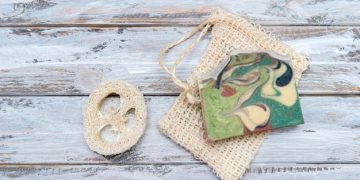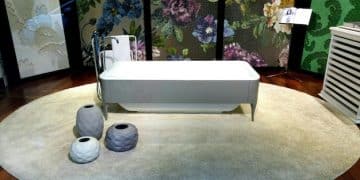Master Welcoming Entryways: Decorating Tips for First Impressions
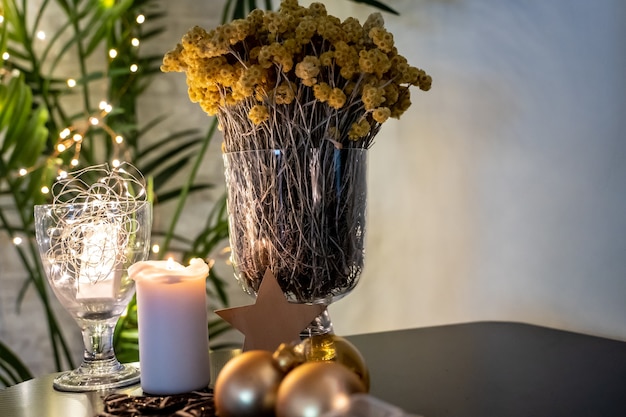
Anúncios
Achieving a truly welcoming entryway involves a strategic blend of personal style, functional organization, and thoughtful design elements that create a memorable first impression, setting the tone for your entire home.
The entryway is more than just a transition space; it’s the opening statement your home makes to every visitor. Crafting a genuinely inviting atmosphere in this often-overlooked area is crucial for setting the right tone. This guide explores The Secrets to Creating a Welcoming Entryway: Decorating Tips for First Impressions, ensuring your home greets guests with warmth and style from the moment they step through the door.
Understanding the Entryway’s Role in Home Decor
The entryway, whether a grand foyer or a modest landing, plays a pivotal role in the overall aesthetic and functionality of your home. It’s the first space guests experience, and as such, it significantly contributes to their initial perception. This initial impression isn’t just about visual appeal; it also encompasses the feeling and practicality of the space.
Consider your entryway as the handshake of your home. A strong, confident handshake leaves a positive, lasting mark. Similarly, a well-designed entryway communicates a sense of care, organization, and hospitality. It should be a seamless transition from the outside world into your personal sanctuary, effortlessly blending form and function to serve both daily needs and aesthetic desires.
More Than Just a Pass-Through
Many homeowners view the entryway merely as a pass-through area, neglecting its potential. However, it’s a critical zone that demands attention. It acts as a buffer, providing a dedicated spot for shedding outdoor gear and preparing to enter or exit. Ignoring this space can lead to clutter spilling into other areas of the home, diminishing the overall sense of order and welcome.
The entryway is also an opportunity to introduce your home’s personality and design style. It’s a preview of what’s to come, subtly hinting at the decor themes and ambiance found in connecting rooms. A thoughtful entryway can enhance the flow of your home, making it feel more cohesive and intentionally designed. Think of it as a small, curated gallery that sets the stage for the rest of your living space.
- First Impression: It dictates how visitors perceive your home.
- Functional Zone: Serves as a drop-off point for keys, mail, and coats.
- Style Preview: Introduces your home’s aesthetic and personality.
- Transitional Space: Bridges the gap between the exterior and interior.
Ultimately, a well-conceived entryway is not an afterthought but an integral part of your home’s design strategy. It offers a chance to combine practical storage solutions with appealing decor, demonstrating that even the smallest spaces can be both beautiful and highly functional. By understanding and embracing its multifaceted role, you lay the groundwork for a truly welcoming home environment.
Strategic Placement and Furniture Selection
When designing a welcoming entryway, strategic placement of furniture is paramount. The goal is to optimize both functionality and visual appeal, ensuring the space feels inviting and organized rather than cramped or chaotic. Every piece selected should serve a purpose, contributing to the overall utility and aesthetic of the area.
Start by assessing the size and layout of your entryway. A grand foyer can accommodate larger pieces, while a narrow hallway requires more compact, streamlined furniture. The key is to avoid overcrowding, which can make the space feel unwelcoming. Aim for a balanced arrangement that allows for easy movement and provides essential storage or display surfaces.
Essential Furniture Pieces for Any Entryway
Regardless of size, certain furniture items are almost universally beneficial in an entryway. A console table, for instance, offers a convenient surface for dropping keys, mail, or displaying decorative items. Its slim profile makes it suitable for various spaces. If space allows, a bench or ottoman can provide a spot to sit while putting on or taking off shoes, adding a practical touch of comfort.
Beyond these, consider vertical storage solutions like coat racks or wall-mounted shelves, which effectively utilize space without encroaching on valuable floor area. The selections you make should reflect the specific needs of your household, whether it’s managing a busy family’s outdoor gear or simply offering a charming vignette for guests.
- Console Table: Ideal for keys, mail, and decorative accents.
- Bench or Ottoman: Offers seating for shoes and additional storage.
- Coat Rack/Hooks: Essential for hanging coats, bags, and scarves.
- Storage Bins/Baskets: For shoes, umbrellas, and other small items.
Carefully selecting and placing each piece of furniture ensures that your entryway is not only beautiful but also highly functional. The right choices can transform a mundane corner into a well-organized and aesthetically pleasing welcoming zone, reinforcing the positive impression your home aims to create.
Lighting as a Foyer’s Focal Point
The importance of lighting in an entryway cannot be overstated; it’s a silent architect, shaping the perception and ambiance of the space. Proper lighting goes beyond mere illumination; it guides visitors, highlights key features, and immediately establishes a welcoming atmosphere. A poorly lit entryway can feel gloomy and uninviting, regardless of its decor.
When considering entryway lighting, think in layers: ambient, accent, and task lighting. Ambient lighting, usually from an overhead fixture, provides general brightness. Accent lighting, like table lamps or sconces, can highlight art or create warm pools of light. Task lighting might be less common in an entryway but could come from a small lamp on a console for specific activities like checking details before heading out.
Creating Warmth and Functionality with Light
The type of light fixture chosen significantly impacts the overall aesthetic. A statement chandelier or pendant light can serve as a stunning focal point, drawing the eye upwards and adding a touch of elegance. For smaller spaces, flush-mount or semi-flush-mount fixtures offer ample light without overwhelming the area. Wall sconces provide a soft, ambient glow and can enhance architectural details.
Beyond fixture styles, the color temperature of your bulbs is critical. Warm white light (2700K-3000K) typically creates a cozier, more inviting atmosphere, ideal for a welcoming entryway. Incorporating dimmers allows for flexibility, enabling you to adjust the light intensity based on time of day or occasion. This adaptability ensures your entryway always feels just right, whether it’s brightly lit for daytime arrivals or softly glowing for evening visits.
- Overhead Fixtures: Chandeliers, pendants, or flush mounts for ambient light.
- Wall Sconces: Add ambient light and highlight architectural features.
- Table Lamps: Provide localized accent lighting on console tables.
- Smart Lighting: Integrate dimmers and smart bulbs for adjustable ambiance.
Thoughtful lighting design transforms an entryway from a functional space into an experience. It signals warmth, guidance, and attention to detail, making a significant impact on your home’s initial greeting. By carefully considering fixture types, placement, and light quality, you can create an entryway that truly shines and welcoming.
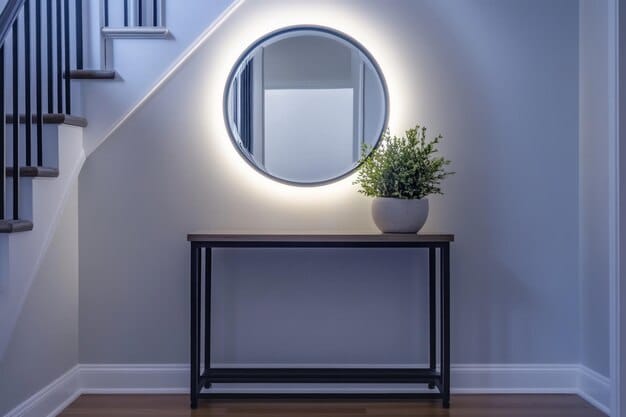
The Art of Accessory Selection and Personal Touches
Accessories are the soul of an entryway; they are what truly infuse personality and warmth into the space. Beyond mere decoration, well-chosen accessories transform a functional area into a captivating introduction to your home. They are opportunities to tell a story, reflect your style, and create visual interest that draws guests further inside.
When selecting accessories, aim for a balance between aesthetics and utility. A decorative bowl on a console table is not only beautiful but also provides a convenient spot for keys. A stylish mirror serves a practical purpose for last-minute checks while also expanding the visual space and reflecting light. Each item should feel intentional, contributing to the overall design narrative without creating clutter.
Infusing Personality and Vibrancy
This is where your house becomes a home. Personal touches are what make an entryway unique to you. Incorporate elements that speak to your interests, travels, or family history. A framed piece of art that you love, a small collection of meaningful objects, or a potted plant that brings life and freshness – these additions make the space genuinely inviting and reflective of the inhabitants.
Consider sensory elements as well. A subtle, pleasant scent from a diffuser or a fresh bouquet of flowers can elevate the experience. Textural elements, such as a plush rug or a woven basket, add depth and visual warmth. These curated details don’t just fill a space; they create an atmosphere, making visitors feel instantly comfortable and curious to explore more of your home’s charm.
- Mirrors: Add depth, reflect light, and offer a last-minute check.
- Artwork: Personalize the space and introduce your style.
- Vases and Plants: Bring life, freshness, and natural texture.
- Decorative Trays/Bowls: Contain small items and add visual appeal.
The art of accessory selection lies in layering and curating. Each piece, from an antique find to a vibrant plant, should contribute to a cohesive and inviting narrative. By thoughtfully choosing items that resonate with your personal style and enhance the functionality of the space, you can create an entryway that leaves a lasting and delightful impression.
Organizing for a Clutter-Free Welcome
Clutter can quickly diminish the welcoming appeal of any entryway, transforming it from an inviting space into a chaotic bottleneck. Effective organization is therefore not just about tidiness; it’s about creating a sense of calm and order that immediately puts guests at ease. A clutter-free entryway ensures smooth transitions and reinforces the idea of a well-maintained home.
The challenge often lies in managing the influx of daily items: coats, shoes, bags, mail, and keys. Without a designated spot for each, these items quickly accumulate, overwhelming surfaces and pathways. The key is to implement smart storage solutions that are both accessible and discreet, allowing for quick tidying and maintaining a streamlined appearance.
Smart Storage Solutions for Every Entryway
Begin by identifying the primary culprits of clutter in your entryway. Is it shoes? Consider a low-profile shoe cabinet or decorative baskets. Coats and jackets? Wall-mounted hooks or a slim hall tree can be invaluable. Mail and keys can be contained in a stylish tray or wall-mounted organizer. The goal is to give every item a home, making it easy to put things away and reducing visual noise.
Think vertically to maximize space, especially in smaller entryways. Vertical shelving, tall slim cabinets, or even a ladder shelf can provide significant storage without occupying much floor area. Integrating these solutions seamlessly into your decor ensures that functionality doesn’t come at the expense of style. An organized entryway reflects a thoughtful approach to home management, fostering a genuinely welcoming environment for all.
- Shoe Storage: Cabinets, benches with storage, or attractive baskets.
- Coat Management: Wall hooks, a hall tree, or a dedicated closet.
- Mail & Keys: Decorative trays, wall organizers, or small drawers.
- Hidden Storage: Ottomans with lift-tops, closed cabinets, or bins.
Ultimately, a welcoming entryway is one where functionality meets aesthetic appeal. By proactively implementing intelligent organizational strategies, you ensure that this crucial space remains clutter-free, inviting, and truly reflective of a home that values both beauty and practicality. An organized entryway leaves a powerful, positive first impression on everyone who enters.
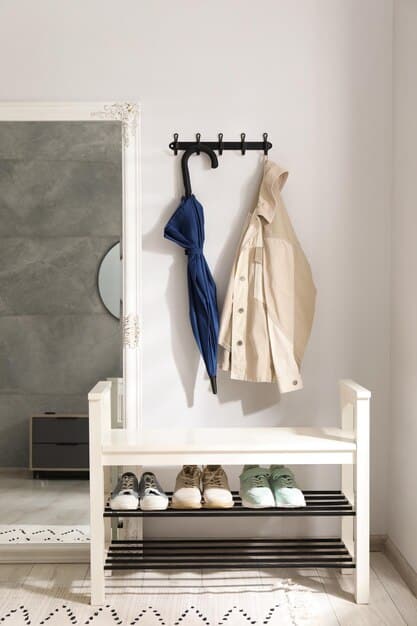
Seasonal Adaptations and Freshness
A truly welcoming entryway is one that feels alive and responsive to the changing seasons. Adapting your decor to reflect the time of year or upcoming holidays adds a dynamic element, ensuring the space always feels fresh, relevant, and engaging. This seasonal adaptability prevents the entryway from becoming stagnant and enhances its ability to make a memorable first impression.
Incorporating seasonal elements doesn’t require a complete overhaul. Small, thoughtful updates can make a significant impact. Consider swapping out textiles, like throw blankets or decorative pillows on a bench, to match the season’s palette. A rich, warm rug in fall can give way to lighter, brighter hues in spring, instantly altering the mood of the space.
Bringing Nature Indoors Year-Round
One of the easiest and most impactful ways to introduce seasonal freshness is through natural elements. In autumn, a vase filled with colorful leaves, gourds, or miniature pumpkins can evoke a cozy, harvest feel. Winter might bring evergreen branches, pinecones, or festive berries. Spring calls for fresh flowers like tulips or daffodils, while summer offers vibrant blooms and lush greenery.
Beyond live plants, consider incorporating seasonal scents through candles, diffusers, or potpourri. A pumpkin spice scent in October, pine in December, and fresh linen in spring can subtly enhance the visitor’s experience, appealing to more than just their visual sense. These small, fluid changes keep your entryway feeling vibrant and aligned with the rhythm of the year, ensuring it always provides a delightful and current welcome.
- Seasonal Blooms: Fresh flowers or branches reflecting the current season.
- Textile Swaps: Change rugs, throws, or decorative pillows.
- Holiday Decor: Integrate subtle touches for festivities.
- Natural Elements: Pinecones, gourds, shells, depending on the season.
By regularly refreshing your entryway’s decor with seasonal touches, you ensure it remains an inviting and dynamic space. This approach demonstrates attention to detail and creates a living environment that continually delights both residents and guests, solidifying its role as a genuinely welcoming introduction to your home.
Maintaining a Consistently Inviting Entryway
Creating a welcoming entryway is an ongoing process, not a one-time project. Consistent maintenance is crucial to ensuring that this crucial space always lives up to its potential as the first impression of your home. A beautifully designed entryway can quickly lose its charm if it becomes neglected, cluttered, or simply unkempt.
Regular tidying should be part of your daily routine. This means immediately putting away shoes, hanging up coats, and sorting mail as soon as you enter the house. Establishing these habits for everyone in the household will prevent clutter from accumulating, preserving the serene and organized atmosphere you’ve worked to create. A few minutes of effort each day can save hours of cleanup later.
Simple Habits for Lasting Appeal
Beyond daily tidiness, consider a weekly or bi-weekly reset for your entryway. This might involve dusting surfaces, wiping down mirrors, and vacuuming or sweeping the floor. If you have plants, ensure they are watered and healthy. Rotating seasonal decor or refreshing artificial arrangements helps keep the space looking vibrant and cared for.
Regularly assess the functionality of your storage solutions. Are they still meeting your needs? Do they need to be decluttered or reorganized? As families grow and habits change, storage requirements may also evolve. Being proactive in adjusting these elements ensures the entryway remains efficiently organized and continues to contribute positively to your home’s welcoming ambiance. Maintaining an inviting entryway is a testament to mindful living and attention to detail.
- Daily Tidy-Up: Put away coats, shoes, and bags immediately.
- Regular Cleaning: Dust surfaces, clean mirrors, and sweep floors weekly.
- Decluttering: Periodically remove unnecessary items.
- Seasonal Refresh: Update decor elements to keep it current.
By integrating these simple maintenance habits into your routine, you can ensure your entryway consistently provides a warm, organized, and inviting welcome. It’s an investment in your home’s overall appeal and a reflection of the care you put into creating a comfortable and pleasant living environment for everyone who crosses your threshold.
| Key Element | Brief Description |
|---|---|
| ✨ Lighting | Crucial for ambiance, warmth, and setting the mood. |
| 🪑 Furniture | Console, bench, and storage key for functionality. |
| 🪴 Accessories | Mirrors, art, plants to personalize and add charm. |
| 🧹 Organization | Clutter-free space is inviting, requires smart storage. |
Frequently Asked Questions About Entryway Decor
To make a small entryway feel larger, utilize mirrors strategically, as they reflect light and create an illusion of space. Opt for light color palettes on walls and floors. Choose slim, wall-mounted furniture like floating shelves or narrow console tables to maximize floor space. Good lighting can also notably open up a confined area, making it feel less cramped and more inviting.
A functional entryway should include a surface for dropping keys and mail, like a console table or shelf. Storage for coats and shoes is crucial, often provided by hooks, a coat rack, or a shoe cabinet. Seating, such as a bench, is also beneficial for putting on or taking off shoes. Adequate lighting and a mirror complete the essentials for practicality.
Choosing the right lighting depends on your entryway’s size and ceiling height. For high ceilings, a chandelier or pendant creates a focal point. Lower ceilings benefit from flush-mount fixtures. Wall sconces add ambient light and warmth. Always opt for warm-toned bulbs (around 2700K-3000K) to ensure a cozy and inviting atmosphere, making guests feel instantly welcomed.
Personalize your entryway with items that reflect your style and interests. This could include cherished artwork or photographs, unique vases, or a curated collection of small decorative objects. Incorporating fresh flowers or a live plant adds nature’s touch. A colorful rug or a distinctive piece of furniture can also immediately infuse personality into the space, making it uniquely yours.
Storage is incredibly important in an entryway to prevent clutter and maintain an organized, welcoming appearance. Smart solutions include benches with hidden storage compartments, slim shoe cabinets, wall-mounted coat hooks, and decorative baskets for items like umbrellas or bags. Vertical storage also maximizes space in smaller areas, ensuring every item has a designated, accessible place.
Conclusion
Ultimately, a welcoming entryway serves as the first chapter of your home’s story, setting the stage for every experience within. By thoughtfully combining strategic furniture placement, layers of inviting lighting, curated accessories that reflect your personality, and intelligent organizational solutions, you can transform this often-underestimated space into a true highlight. Consistent maintenance ensures its lasting appeal. Investing time and creativity in your entryway decor not only enhances your home’s aesthetic but also lays the groundwork for a warm, comfortable, and memorable impression for all who enter.

